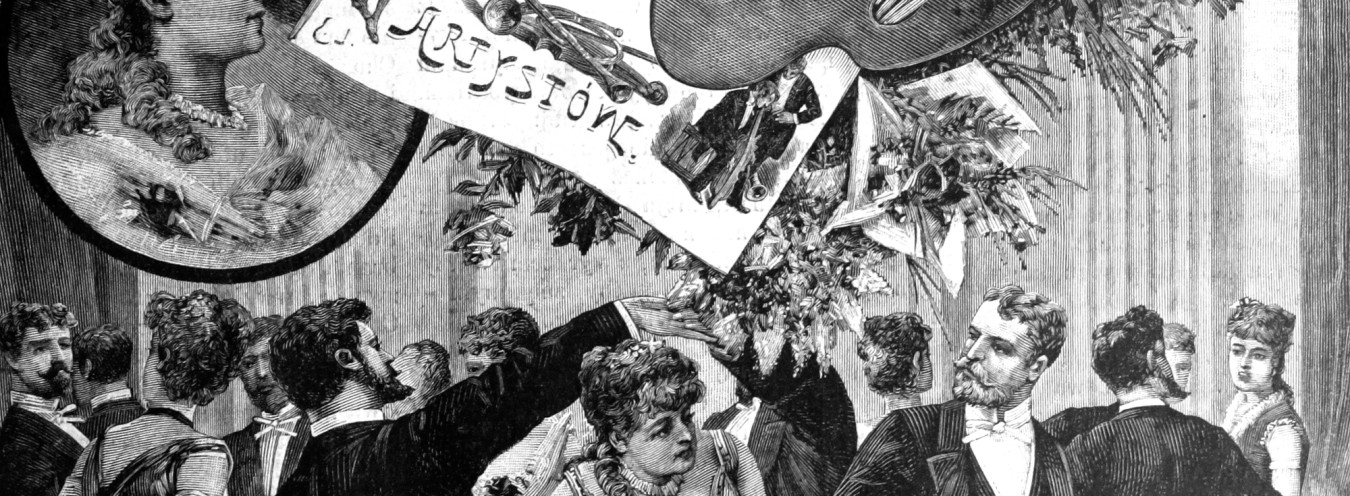
Balls
[Wokulski on Izabela Łęcka:] What was she interested in? Balls, parties, concerts, clothes… (580)
Balls were an integral element of social life that allowed their participants, especially women, to show off their beauty and exquisite garments. They were also occasions for both sexes to flash their charm and witty conversation as well as make acquaintances that could in time develop into commitment and marriage. Charitable causes often served as a pretext to hold parties. As stated in Orgelbrand’s Universal Encyclopaedia: Both in terms of the number of guests and sumptuous reception, parties are usually grander than the so-called dinner dances. Parties at the court are either parés-type, with men turning up in uniforms, or family-type; there are also masked balls […], public and private.
In the second half of the nineteenth century, the number of grand parties held by the Polish community was greatly limited. The ones staged at the Presidential Palace in Warsaw (the seat of Russian-imposed governors) were largely ignored by Poles since participating in them was seen by many as an act of submission to the occupiers. In the period of national mourning, which started with the Warsaw demonstrations of 1861, all merrymaking and dances were criticised and frowned upon. Parties took place mainly in the carnival seasons (in the winter and the spring, which was called the “Green Carnival” and started right after Easter); the Church disapproved of them during Advent and Lent periods. As regards public parties, middle-class communities had them staged in the Resursa Kupiecka (Commercial Club), while the gentry and the aristocracy used the Resursa Obywatelska (Civil Club). As a rule, class divisions were strictly observed. Dinner dances (which brought together fewer people and had a less lavish character) were organised in private and often financed with contributions from the participants.
In The Doll, the motif of parties is primarily connected with Izabela Łęcka. She is said to be everlastingly at balls in Carnival, and her beauty is a real asset to any party, public or private. Such social meetings, given mostly to dancing, flirting, small-talking and gossiping, are depicted with bitter irony e.g. through some telling names of their participants: the poetic Mr Szastalski (“szastać” means “to squander”), Mrs de Gins Upadalska (“Gins” evokes gin, whereas “upaść” is “fall down”), and Mrs de Fertalski Wywrotnicka (“wywrócić się” means to “fall down”), who make a far-from-subtle biting remark on Izabela as a charming unmarried girl of a certain age.
Dancing balls in the meaning of entertainment for select, mostly aristocratic guests are usually rendered from the outside perspective of those not invited. For instance, Doctor Szuman becomes irritated with Wokulski mortifying himself for two days because some prince or other hasn’t asked him to a ball, and the protagonist himself stands in the street to look up at the dancing shadows in the Prince’s windows. Rzecki and his social group know no more about parties than what can be learnt about them from the press. Sometimes, they can actually see through to their much less appealing side: unpaid dress bills and sheer arrogance with which beautiful ladies treat their seamstresses.
In the novel, the term “ball” is often used metaphorically. Back in 1848, when the young Ignacy Rzecki says goodbye to his uncle before setting off to war, he is given fifteen half-imperials and a word of warning: not everyone comes back from this kind of a ball. Baron Dalski uses the word to refer to the hospitality of Duchess Zasławska: on a fine Sunday it’s like being at a ball at one’s club: dozens of people drive over. And Kazimiera Wąsowska tellingly compares high hopes of love to the expectations one has of the first ball – just to realise that it has already happened before, or is nothing.
→ Marriage; →Restaurants and Cafés; → Pastimes;
Bibliografia
- Encyklopedyja powszechna S. Orgelbranda, vol. 2, Warsaw 1862.
- Kałwa, Polska doby rozbiorów i międzywojenna, in Obyczaje w Polsce. Od średniowiecza do czasów współczesnych, ed. A. Chwalba, Warsaw 2006.



